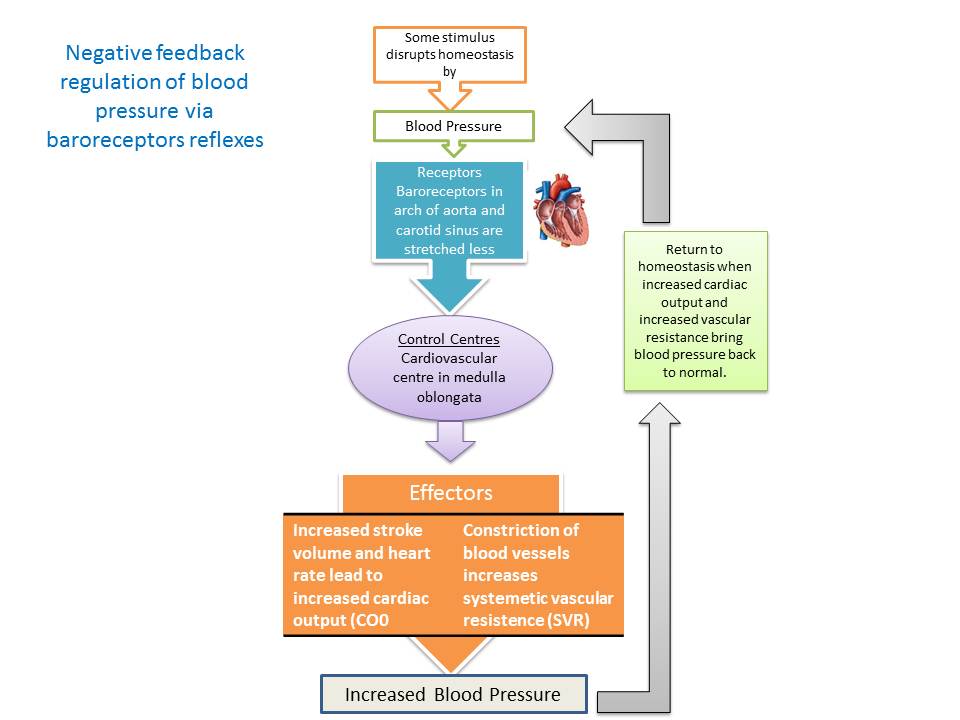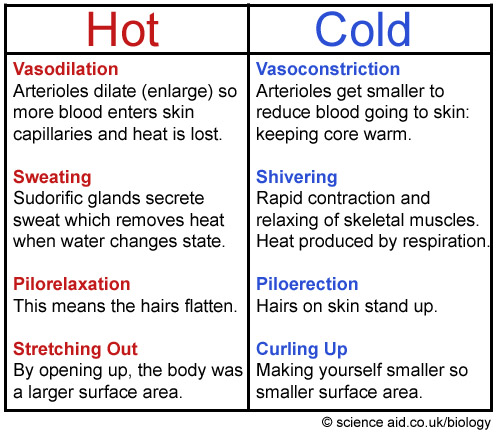What are the main mechanisms of homeostasis?
Human body include mechanisms that help regulate the body, this includes organs, glands, tissues and cells. The adjusting of these enables the body to constantly be in a steady state. The main mechanisms of homeostasis are body temperature, body fluid composition, blood sugar, gas concentrations, and blood pressure.
Blood Pressure
Pressure by which the blood is pumped around the body is controlled by a homeostatic mechanism.
Blood Pressure
Pressure by which the blood is pumped around the body is controlled by a homeostatic mechanism.
Body Temperature
There are two types of heat regulation
that the body uses, endothermic and ectothermic. Endothermic is where a living
thing can maintain their own core temperature and ectothermic is where it gains
the temperture of its surrounding environment. living things that regulate its
own temperature are detected by receptors in the skin and hypothalamus in the
brain. then nerve impulses are sent when ther is a temperature change. this then
brings change depending on whether it is hot or cold, signaling to the muscles
and glands. Below are some examples of what the body will do to regulate and
maintain the body's body temperature.
There are two types of heat regulation
that the body uses, endothermic and ectothermic. Endothermic is where a living
thing can maintain their own core temperature and ectothermic is where it gains
the temperture of its surrounding environment. living things that regulate its
own temperature are detected by receptors in the skin and hypothalamus in the
brain. then nerve impulses are sent when ther is a temperature change. this then
brings change depending on whether it is hot or cold, signaling to the muscles
and glands. Below are some examples of what the body will do to regulate and
maintain the body's body temperature.
Body Fluids:
An important part in maintaining a balance in the body is the
maintenance of body fluids, dilute and watery solutions that contain dissolved
chemicals found inside cells and the surroundings of them. Inside the cells it
is called intracellular fluid; outside of the cells it is called extracellular
fluid. All the substances such as oxygen, nutrients, proteins and ions, are
needed to maintain life. The
composition of interstitial fluid changes as substances move back and forth
between it and the blood plasma, this occurs across the thin wall of the
smallest blood vessels in the body, the blood capillaries. Carbon dioxide is
removed from intestinal fluid.
(Homeostasis – Part 1: anatomy and physiology, ©2012)
An important part in maintaining a balance in the body is the
maintenance of body fluids, dilute and watery solutions that contain dissolved
chemicals found inside cells and the surroundings of them. Inside the cells it
is called intracellular fluid; outside of the cells it is called extracellular
fluid. All the substances such as oxygen, nutrients, proteins and ions, are
needed to maintain life. The
composition of interstitial fluid changes as substances move back and forth
between it and the blood plasma, this occurs across the thin wall of the
smallest blood vessels in the body, the blood capillaries. Carbon dioxide is
removed from intestinal fluid.
(Homeostasis – Part 1: anatomy and physiology, ©2012)
Regulation of gas concentration
The cells in the body require oxygen, but also removing all carbon dioxide as it is a waste product, so that sufficient energy can be produced. this is needed to be regulated and is controlled by the homeostatic mechanism that controls breathing. some control is over this function unlike other processes that there is none. the intercoastal muscles, the lungs and diaphram move air in and out of the lungs. the muscles are controlled by nerve impulses that are sent to the medulla oblongata from the respitory system.
(hoomeostasis, copyright westone services),
The cells in the body require oxygen, but also removing all carbon dioxide as it is a waste product, so that sufficient energy can be produced. this is needed to be regulated and is controlled by the homeostatic mechanism that controls breathing. some control is over this function unlike other processes that there is none. the intercoastal muscles, the lungs and diaphram move air in and out of the lungs. the muscles are controlled by nerve impulses that are sent to the medulla oblongata from the respitory system.
(hoomeostasis, copyright westone services),
Blood sugar (explained on a different page), click here to go too it.


